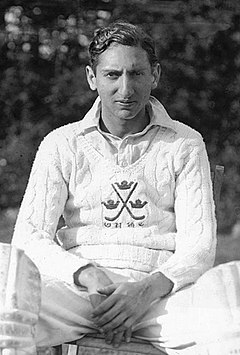| Mohammad Iftikhar Ali Khan of Pataudi | ||||||||||||||||||||||||||||||||||||||||
|---|---|---|---|---|---|---|---|---|---|---|---|---|---|---|---|---|---|---|---|---|---|---|---|---|---|---|---|---|---|---|---|---|---|---|---|---|---|---|---|---|
| Nawab of Pataudi | ||||||||||||||||||||||||||||||||||||||||
 Iftikhar Ali Khan Pataudi in 1931 | ||||||||||||||||||||||||||||||||||||||||
| Nawab of Pataudi | ||||||||||||||||||||||||||||||||||||||||
| Reign | 1917–1948 1948–1952 (titular ruler) | |||||||||||||||||||||||||||||||||||||||
| Coronation | December 1931 | |||||||||||||||||||||||||||||||||||||||
| Predecessor | Muhammad Ibrahim Ali Khan Pataudi | |||||||||||||||||||||||||||||||||||||||
| Successor | Mansoor Ali Khan Pataudi (as titular ruler) | |||||||||||||||||||||||||||||||||||||||
| Born | Mohammad Iftikhar Ali Khan Pataudi 16 March 1910 Pataudi, Pataudi State, British India (present-day Haryana, India) | |||||||||||||||||||||||||||||||||||||||
| Died | 5 January 1952 (aged 41) New Delhi, India | |||||||||||||||||||||||||||||||||||||||
| Burial | ||||||||||||||||||||||||||||||||||||||||
| Consort | Sajida Sultan | |||||||||||||||||||||||||||||||||||||||
| Issue | Mansoor Ali Khan Pataudi and 3 daughters | |||||||||||||||||||||||||||||||||||||||
| House | Pataudi | |||||||||||||||||||||||||||||||||||||||
| Father | Muhammad Ibrahim Ali Khan Pataudi | |||||||||||||||||||||||||||||||||||||||
| Mother | Shahar Bano Begum | |||||||||||||||||||||||||||||||||||||||
| Religion | Sunni Islam | |||||||||||||||||||||||||||||||||||||||
| Occupation | Cricketer and Civil servant | |||||||||||||||||||||||||||||||||||||||
| Personal information | ||||||||||||||||||||||||||||||||||||||||
| Nickname | Pat | |||||||||||||||||||||||||||||||||||||||
| Height | 6 ft 0 in (1.83 m) | |||||||||||||||||||||||||||||||||||||||
| Batting | Right-handed | |||||||||||||||||||||||||||||||||||||||
| International information | ||||||||||||||||||||||||||||||||||||||||
| National sides | ||||||||||||||||||||||||||||||||||||||||
| Test debut (cap 265/32) | 2 December 1932 England v Australia | |||||||||||||||||||||||||||||||||||||||
| Last Test | 20 August 1946 India v England | |||||||||||||||||||||||||||||||||||||||
| Domestic team information | ||||||||||||||||||||||||||||||||||||||||
| Years | Team | |||||||||||||||||||||||||||||||||||||||
| 1928–1931 | Oxford University | |||||||||||||||||||||||||||||||||||||||
| 1932–1938 | Worcestershire | |||||||||||||||||||||||||||||||||||||||
| 1945/46 | Southern Punjab | |||||||||||||||||||||||||||||||||||||||
| Career statistics | ||||||||||||||||||||||||||||||||||||||||
| ||||||||||||||||||||||||||||||||||||||||
Source: ESPNcricinfo, 12 May 2009 | ||||||||||||||||||||||||||||||||||||||||
Nawab Mohammad Iftikhar Ali Khan Pataudi, sometimes I. A. K. Pataudi (16 March 1910 – 5 January 1952), was an Indian prince and cricket player.
He was the captain of the India's national cricket team during its tour of England in 1946. His son Mansoor, known as the Nawab of Pataudi Jr., also later served as captain of the India cricket team.
He also played Test cricket for the England team in 1932 and 1934, making him one of the few cricketers to have played Test cricket for two countries and the only Test cricketer to have played for both India and England.[1] He played in six Tests in all, three as captain of India and three for England.[2]
Pataudi was the ruling Nawab of the princely state of Pataudi during the British Raj from 1917 until 1947. After the state was absorbed into independent India, he was granted a privy purse, certain privileges, and the use of the title Nawab of Pataudi by the Government of India,[3] which he retained until his death in 1952.
- ^ "Royalty on the cricket field". International Cricket Council. Retrieved 18 May 2018.
- ^ "Herschelle the bully". ESPNcricinfo. 16 March 2006. Retrieved 21 March 2018.
- ^ Ramusack, Barbara N. (2004). The Indian princes and their states. Cambridge University Press. p. 273. ISBN 978-0-521-26727-4.
The crucial document was the Instrument of Accession by which rulers ceded to the legislatures of India or Pakistan control over defence, external affairs, and communications. In return for these concessions, the princes were to be guaranteed a privy purse in perpetuity and certain financial and symbolic privileges such as exemption from customs duties, the use of their titles, the right to fly their state flags on their cars, and to have police protection. ... By December 1947 Patel began to pressure the princes into signing Merger Agreements that integrated their states into adjacent British Indian provinces, soon to be called states or new units of erstwhile princely states, most notably Rajasthan, Patiala and East Punjab States Union, and Matsya Union (Alwar, Bharatpur, Dholpur and Karaulli).